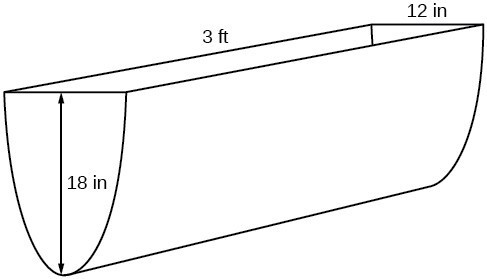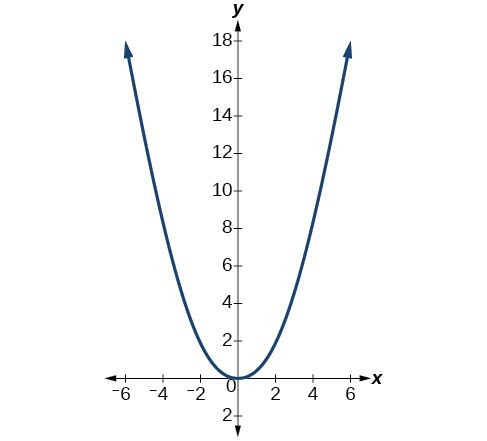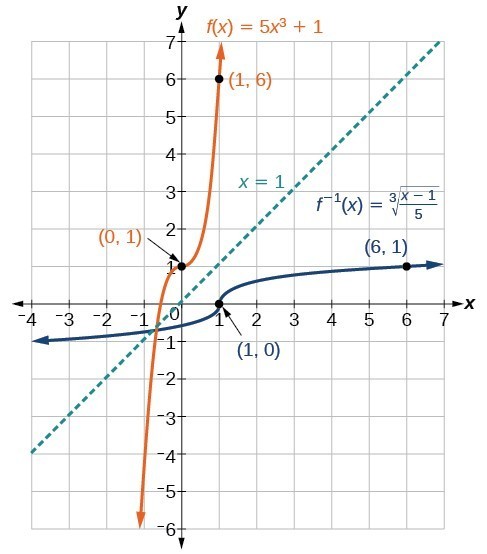Radicals as Inverse Polynomial Functions
Learning Objectives
- Verify that a radical and a polynomial function are inverses of each other
- Find the inverse of a polynomial function
 Because it will be helpful to have an equation for the parabolic cross-sectional shape, we will impose a coordinate system at the cross section, with x measured horizontally and y measured vertically, with the origin at the vertex of the parabola.
Because it will be helpful to have an equation for the parabolic cross-sectional shape, we will impose a coordinate system at the cross section, with x measured horizontally and y measured vertically, with the origin at the vertex of the parabola.
 From this we find an equation for the parabolic shape. We placed the origin at the vertex of the parabola, so we know the equation will have form [latex]y\left(x\right)=a{x}^{2}[/latex]. Our equation will need to pass through the point (6, 18), from which we can solve for the stretch factor a.
From this we find an equation for the parabolic shape. We placed the origin at the vertex of the parabola, so we know the equation will have form [latex]y\left(x\right)=a{x}^{2}[/latex]. Our equation will need to pass through the point (6, 18), from which we can solve for the stretch factor a.
[latex]\begin{array}{l} 18=a{6}^{2}\hfill \\ a=\frac{18}{36}\hfill \\ \text{ }=\frac{1}{2}\hfill \end{array}[/latex]
Our parabolic cross section has the equation[latex]y\left(x\right)=\frac{1}{2}{x}^{2}[/latex]
We are interested in the surface area of the water, so we must determine the width at the top of the water as a function of the water depth. For any depth y the width will be given by 2x, so we need to solve the equation above for x and find the inverse function. However, notice that the original function is not one-to-one, and indeed, given any output there are two inputs that produce the same output, one positive and one negative. To find an inverse, we can restrict our original function to a limited domain on which it is one-to-one. In this case, it makes sense to restrict ourselves to positive x values. On this domain, we can find an inverse by solving for the input variable:[latex]\begin{array}{l}y=\frac{1}{2}{x}^{2}\hfill \\ 2y={x}^{2}\hfill \\ \text{ }x=\pm \sqrt{2y}\hfill \end{array}[/latex]
This is not a function as written. We are limiting ourselves to positive x values, so we eliminate the negative solution, giving us the inverse function we’re looking for.[latex]y=\frac{{x}^{2}}{2},\text{ }x>0[/latex]
Because x is the distance from the center of the parabola to either side, the entire width of the water at the top will be 2x. The trough is 3 feet (36 inches) long, so the surface area will then be:[latex]\begin{array}{l}\text{Area} & =l\cdot w\hfill \\ \text{ } & =36\cdot 2x\hfill \\ \text{ } & =72x\hfill \\ \text{ } & =72\sqrt{2y}\hfill \end{array}[/latex]
This example illustrates two important points:- When finding the inverse of a quadratic, we have to limit ourselves to a domain on which the function is one-to-one.
- The inverse of a quadratic function is a square root function. Both are toolkit functions and different types of power functions.
[latex]{f}^{-1}\left(f\left(x\right)\right)=x,\text{for all }x\text{ in the domain of }f[/latex]
and[latex]f\left({f}^{-1}\left(x\right)\right)=x,\text{for all }x\text{ in the domain of }{f}^{-1}[/latex]
A General Note: Verifying Two Functions Are Inverses of One Another
Two functions, f and g, are inverses of one another if for all x in the domain of f and g. [latex-display]g\left(f\left(x\right)\right)=f\left(g\left(x\right)\right)=x[/latex-display]How To: Given a polynomial function, find the inverse of the function by restricting the domain in such a way that the new function is one-to-one.
- Replace [latex]f\left(x\right)[/latex] with y.
- Interchange x and y.
- Solve for y, and rename the function [latex]{f}^{-1}\left(x\right)[/latex].
Example: Verifying Inverse Functions
Show that [latex]f\left(x\right)=\frac{1}{x+1}[/latex] and [latex]{f}^{-1}\left(x\right)=\frac{1}{x}-1[/latex] are inverses, for [latex]x\ne 0,-1[/latex] .Answer: We must show that [latex]{f}^{-1}\left(f\left(x\right)\right)=x[/latex] and [latex]f\left({f}^{-1}\left(x\right)\right)=x[/latex].
[latex]\begin{array}{l}{f}^{-1}\left(f\left(x\right)\right)={f}^{-1}\left(\frac{1}{x+1}\right)\hfill \\ \text{ }=\frac{1}{\frac{1}{x+1}}-1\hfill \\ \text{ }=\left(x+1\right)-1\hfill \\ \text{ }=x\hfill \\ f\left({f}^{-1}\left(x\right)\right)=f\left(\frac{1}{x}-1\right)\hfill \\ \text{ }=\frac{1}{\left(\frac{1}{x}-1\right)+1}\hfill \\ \text{ }=\frac{1}{\frac{1}{x}}\hfill \\ \text{ }=x\hfill \end{array}[/latex]
Therefore, [latex]f\left(x\right)=\frac{1}{x+1}[/latex] and [latex]{f}^{-1}\left(x\right)=\frac{1}{x}-1[/latex] are inverses.Try It
Show that [latex]f\left(x\right)=\frac{x+5}{3}[/latex] and [latex]{f}^{-1}\left(x\right)=3x - 5[/latex] are inverses.Answer: [latex]{f}^{-1}\left(f\left(x\right)\right)={f}^{-1}\left(\frac{x+5}{3}\right)=3\left(\frac{x+5}{3}\right)-5=\left(x - 5\right)+5=x[/latex] and [latex]f\left({f}^{-1}\left(x\right)\right)=f\left(3x - 5\right)=\frac{\left(3x - 5\right)+5}{3}=\frac{3x}{3}=x[/latex]
Example: Finding the Inverse of a Cubic Function
Find the inverse of the function [latex]f\left(x\right)=5{x}^{3}+1[/latex].Answer: This is a transformation of the basic cubic toolkit function, and based on our knowledge of that function, we know it is one-to-one. Solving for the inverse by solving for x.
[latex]\begin{array}{l}\text{ }y=5{x}^{3}+1\hfill \\ \text{ }x=5{y}^{3}+1\hfill \\ \text{ }x - 1=5{y}^{3}\hfill \\ \text{ }\frac{x - 1}{5}={y}^{3}\hfill \\ {f}^{-1}\left(x\right)=\sqrt[3]{\frac{x - 1}{5}}\hfill \end{array}[/latex]
Analysis of the Solution
Look at the graph of f and [latex]{f}^{-1}[/latex]. Notice that the two graphs are symmetrical about the line [latex]y=x[/latex]. This is always the case when graphing a function and its inverse function. Also, since the method involved interchanging x and y, notice corresponding points. If [latex]\left(a,b\right)[/latex] is on the graph of f, then [latex]\left(b,a\right)[/latex] is on the graph of [latex]{f}^{-1}[/latex]. Since [latex]\left(0,1\right)[/latex] is on the graph of f, then [latex]\left(1,0\right)[/latex] is on the graph of [latex]{f}^{-1}[/latex]. Similarly, since [latex]\left(1,6\right)[/latex] is on the graph of f, then [latex]\left(6,1\right)[/latex] is on the graph of [latex]{f}^{-1}[/latex].
Try It
Find the inverse function of [latex]f\left(x\right)=\sqrt[3]{x+4}[/latex].Answer: [latex]{f}^{-1}\left(x\right)={x}^{3}-4[/latex]
Licenses & Attributions
CC licensed content, Original
- Revision and Adaptation. Provided by: Lumen Learning License: CC BY: Attribution.
CC licensed content, Shared previously
- Question ID 15856. Authored by: Sousa,James. License: CC BY: Attribution. License terms: IMathAS Community License CC-BY + GPL.
- College Algebra. Provided by: OpenStax Authored by: Abramson, Jay et al.. Located at: https://openstax.org/books/college-algebra/pages/1-introduction-to-prerequisites. License: CC BY: Attribution. License terms: Download for free at http://cnx.org/contents/[email protected].
